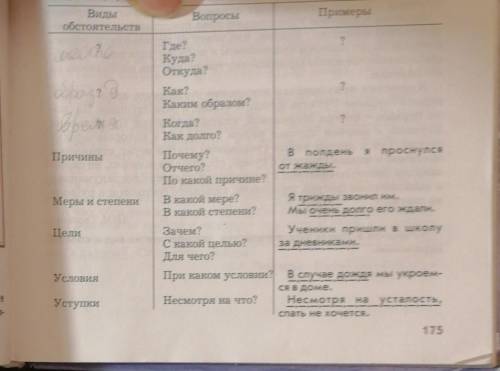Рассмотрите таблицу Озаглавьте Восстановите недостающее информацию

Другие вопросы по теме Русский язык
Популярные вопросы
- Назовите оборудование раскройного цеха?...
2 - кто не может не отвечайте что не можете...
1 - указать род по русскому языку АтельеФламингоСалямиКафеКокшетауКольрабиФилебуратиноледи...
3 - Наверное вам не раз приходилось сталкиваться с такой ситуацией: слабоуспевающий...
3 - 1)I spend my holidays abroad. Past Simple 1)? Present Simple 2) ? Past Simple...
3 - Без чего нельзя сделать сталь?...
3 - 4 – тапсырма. Мәтінді оқы, сұрақтарға жауап бер. (стр 102, прочитайте текст,...
2 - Вычислить площади фигур, ограниченных линиями ...
2 - Выполни сложение. 1 7/12 + 3 5/9 3 1/12 + 4 2/15 если сможете пришлите фото...
3 - Сочинение на тему моё право на счастливое детство ...
1
To answer the question and complete the missing information in the table, let's first understand the different elements mentioned in the table.
1. Kingdoms: The highest classification level for living organisms. There are five main kingdoms:
- Animalia (animals)
- Plantae (plants)
- Fungi (fungi)
- Protista (protists)
- Monera (bacteria and archaea)
2. Phyla: The next level of classification below the kingdom level. Phyla represent different groups of organisms within each kingdom.
Now, let's go through each column in the table step by step and fill in the missing information:
Column 1: Examples of Living Organisms
- Animalia: This kingdom includes organisms such as dogs, cats, birds, insects, fish, and humans.
Column 2: Characteristics
- Animalia: Animals are multicellular organisms that can move, have specialized tissues and organs, and obtain energy by consuming other organisms.
Column 3: Examples of Living Organisms
- Plantae: This kingdom includes organisms such as trees, grass, flowers, ferns, and mosses.
Column 4: Characteristics
- Plantae: Plants are multicellular organisms that have cell walls composed of cellulose, undergo photosynthesis to produce energy, and have specialized structures for water and nutrient absorption.
Column 5: Examples of Living Organisms
- Fungi: This kingdom includes organisms such as mushrooms, yeast, molds, and mildews.
Column 6: Characteristics
- Fungi: Fungi are multicellular or unicellular organisms that have cell walls made of chitin, obtain nutrients by absorbing them from the environment, and reproduce through spores.
Column 7: Examples of Living Organisms
- Protista: This kingdom includes organisms such as amoebas, algae, protozoa, and slime molds.
Column 8: Characteristics
- Protista: Protists are mostly unicellular organisms, but some can be multicellular. They have diverse characteristics and can be both autotrophic (capable of producing their own food) or heterotrophic (obtain food from other sources).
Column 9: Examples of Living Organisms
- Monera: This kingdom includes organisms such as bacteria and archaea.
Column 10: Characteristics
- Monera: Monerans are unicellular organisms that lack a nucleus and membrane-bound organelles. They can be classified as either bacteria or archaea.
Now that the missing information has been filled in, the table should look something like this:
| Kingdom | Examples of Living Organisms | Characteristics |
|-----------|-----------------------------|-------------------------------------------------------------|
| Animalia | Dogs, cats, birds | Multicellular, can move, have specialized tissues, and organs |
| Plantae | Trees, grass, flowers | Multicellular, cell walls made of cellulose, undergo photosynthesis |
| Fungi | Mushrooms, yeast, molds | Multicellular or unicellular, cell walls made of chitin |
| Protista | Amoebas, algae, protozoa | Mostly unicellular, diverse characteristics, can be autotrophic or heterotrophic |
| Monera | Bacteria, archaea | Unicellular, lack a nucleus and membrane-bound organelles |
I hope this explanation helps you understand the table better! If you have any further questions, feel free to ask.